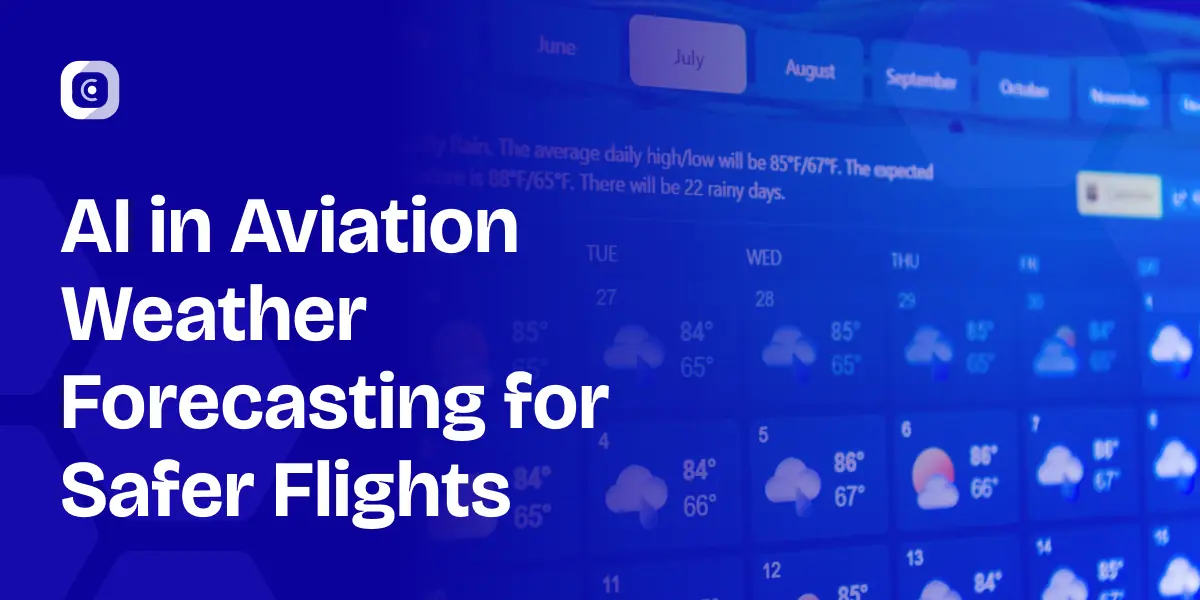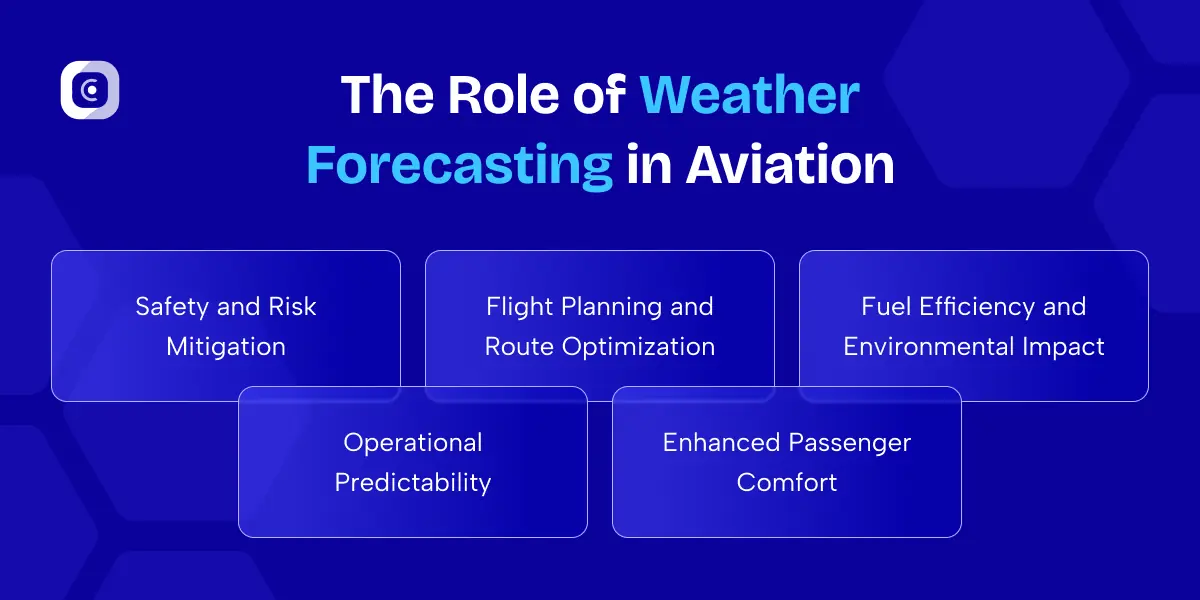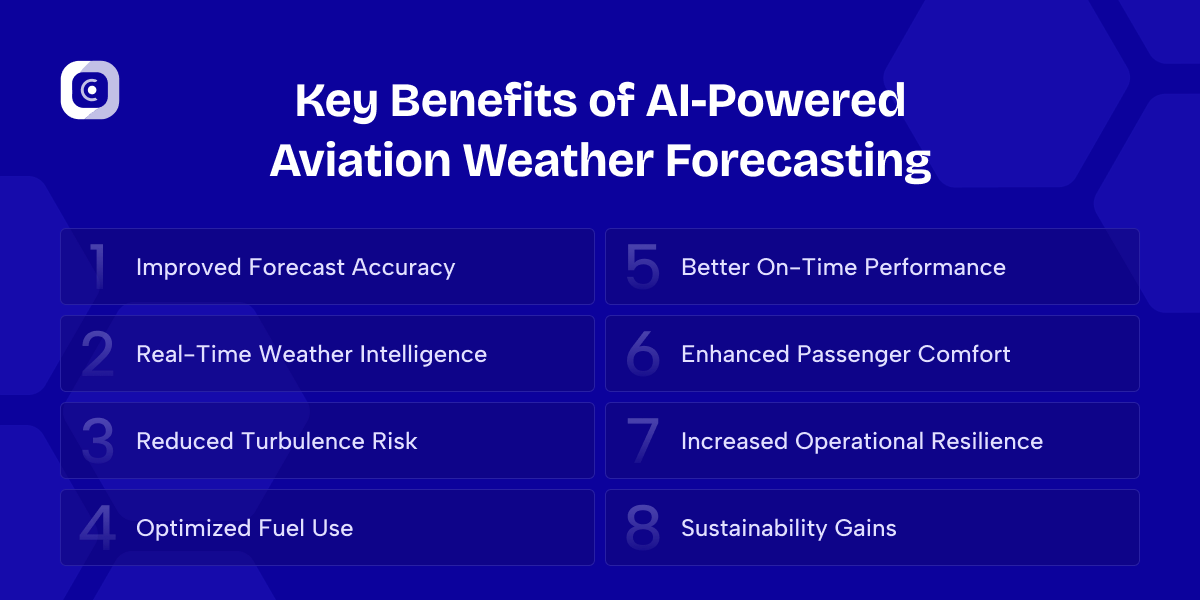AI in Aviation Weather Forecasting: Revolutionizing Flight Safety, Efficiency & Weather Intelligence

Introduction
Weather remains one of the most unpredictable variables in aviation. A sudden storm, an unexpected wind shear event, or severe turbulence can force route deviations, increase fuel burn, delay operations, or worse compromise safety. Historically, pilots and dispatchers have relied on traditional forecasting methods like METARs, TAFs, and static model outputs. These tools, while effective in many cases, often lack the granularity, speed, and predictive power needed for today’s highly dynamic skies.
AI in aviation weather forecasting is reshaping this landscape. By integrating machine learning, deep neural networks, satellite imagery, and real-time aircraft sensor data, artificial intelligence provides hyperlocal predictions, live updates, proactive turbulence alerts, and optimized flight paths. This next generation of weather intelligence doesn’t just forecast it foresees, helping airlines operate more safely, efficiently, and sustainably.
In this exploration, we’ll dive deep into how AI is revolutionizing aviation weather forecasting, its benefits, the technological backbone, and real-world applications as well as the challenges involved. For OneClick IT Consultancy, this means empowering airlines and aviation stakeholders with cutting-edge AI solutions that translate into measurable operational improvements.
The Role of Weather Forecasting in Aviation
Accurate weather forecasting is foundational to operational safety and efficiency in aviation. Its importance spans across both strategic and tactical decision-making. Many airlines today have adopted new-age aviation software solutions to support this evolution.

Safety and Risk Mitigation
Weather hazards like thunderstorms, icing, low visibility, microbursts, and turbulence are among the primary contributors to aviation incidents. Traditional forecasting helps, but often only provides a partial or delayed view. With real-time weather intelligence, AI systems can identify potential danger zones much earlier, enabling crews and dispatchers to adjust flights proactively, as highlighted by ongoing research from NOAA.
Flight Planning and Route Optimization
Flight planning is heavily dependent on understanding wind fields, convective activity, and jet streams. AI’s flight path weather predictions integrate current and forecasted weather to suggest optimized routes, helping airlines avoid dangerous areas and minimize fuel burn.
Fuel Efficiency and Environmental Impact
Fuel costs are one of the largest operational expenses for airlines. By leveraging AI to identify tailwinds, avoid turbulent zones, and optimize altitude, airlines can reduce fuel burn, thereby lowering costs and carbon emissions.
Operational Predictability
Delays caused by weather impact airline schedules, crew logistics, and passenger experience. AI-enabled real-time updates allow operations teams to preemptively reroute or delay departures, increasing on-time performance and reducing disruption.
Enhanced Passenger Comfort
Turbulence is not just a safety concern it also affects comfort and perceived safety among passengers. By predicting turbulent zones, airlines can avoid them or alert crews in advance, improving the overall travel experience.

Challenges in Traditional Weather Forecasting for Aviation
Despite decades of meteorological advancement, traditional weather forecasting still faces significant limitations.
Limitations in Update Frequency
Conventional forecast models often refresh on scheduled intervals (e.g., once every few hours), which may not reflect the latest atmospheric changes. This time lag can be critical in fast-evolving conditions.
Inaccuracy in High-Resolution, Rapid Phenomena
Rapid phenomena like microbursts, gust fronts, or sudden convective cells are extremely difficult to forecast using traditional large-scale models. Without very high resolution, predictions can be generic or misleading.
Lack of Altitude-Resolved Data
Many predictions are made at the surface or broad altitude bands. However, aviation operations require micro-altitude forecasts because atmospheric conditions differ greatly with altitude. Traditional forecasting often lacks this granularity.
Sparse Data over Remote Areas
Remote regions like oceans, polar zones, and high-altitude flight corridors often lack dense sensor coverage. This results in weather intelligence gaps, making long-haul or transoceanic flights especially vulnerable.
Overreliance on Historical Data
Traditional forecasting models lean heavily on climatology and historical trends. While valuable, they may not adapt quickly to new or unusual weather behaviors especially in a changing climate.
Limited Real-Time Flight Data Integration
Many existing systems do not ingest live data from aircraft (e.g., ADS-B, onboard sensors), reducing the precision of route-specific or real-time forecasts.
Computational Constraints
Running very high-resolution forecasting models requires enormous computational power. Many legacy systems are not built to handle the scale needed to simulate micro-weather in real time for individual flight paths.
These challenges make the case for a more intelligent, AI-driven approach which brings us to the next section.
The Emergence of AI in Aviation
AI is no longer just a buzzword in aviation it is rapidly becoming an operational imperative. Here’s how AI is reshaping multiple facets of the industry.
AI in Aviation Safety
AI analyzes live and historical flight data, environmental inputs, and weather simulations to anticipate hazards like turbulence, icing, or wind shear. Rather than waiting for human reports, AI systems provide real-time alerts and decision support for pilots and dispatchers, significantly reducing risk.
AI in Aviation Maintenance
Predictive maintenance powered by AI models takes into account stressors like temperature, humidity, wind exposure, and flight cycles to predict component degradation. This reduces downtime and minimizes unexpected weather-related failures.
AI in Flight Planning & Optimization
AI-driven flight planning tools consider real-time weather intelligence to optimize routes, altitudes, and speed profiles for each flight. This improves fuel efficiency and resilience to weather disruption.
AI in Air Traffic Management
AI systems support air traffic controllers by analyzing weather plus traffic data, offering reroute suggestions, conflict resolution, and flow optimization. This enables smarter, weather-aware traffic management.
AI in Passenger Experience
From personalized rebooking when weather disrupts flights to chatbot support and predictive notifications, AI enhances the customer journey through proactive communication and automated service recovery.
How AI Transforms Weather Forecasting for Flights
This is where the technical magic happens. AI turns static weather data into actionable insights for flight operations, combining predictive analytics, real-time intelligence, and proactive risk mitigation.
Predictive Analytics & Weather Modeling
AI platforms run predictive models that combine long-term climatology, real-time satellite feeds, historical flight data, and weather station inputs. This multilayered approach helps forecast not just “what is happening” but “what is likely to happen,” particularly for turbulence, convective storms, and wind shear.
Machine Learning for Atmospheric Dynamics
Machine learning models are trained on vast datasets to understand cloud microphysics, moisture transport, boundary-layer dynamics, and wind fields. This allows for better modeling of phenomena like updrafts, downdrafts, storm initiation, and dissipation.
Real-Time Weather Updates & Flight Weather Information
AI systems continuously process incoming data from satellites, radars, and aircraft sensors to update forecast products in real time. Pilots and dispatchers access flight weather information via intuitive dashboards or apps, enabling them to make smarter decisions mid-flight.
AI-Driven Turbulence Prediction
Perhaps the most critical benefit is predicting turbulence before it occurs. AI systems ingest data from:
- Onboard accelerometers and gyros
- Historical turbulence reports
- Jet stream forecasts
- High-resolution wind models
They produce a dynamic turbulence risk map (sometimes referred to as an air turbulence potential map), enabling route changes that avoid bumps and improve passenger safety.
AI-Integrated Satellites & Global Weather Monitoring
One of the most groundbreaking developments in weather forecasting is the use of AI-integrated satellites.
Real-Time, Global Data Coverage
Unlike traditional satellite systems, AI-enabled satellites process data onboard and send meaningful, pre-interpreted information to ground systems. This fills in critical coverage gaps, especially over remote or data-sparse regions like oceans and polar routes.
Intelligent Interpretation of Atmospheric Data
These satellites use onboard machine learning to classify cloud types, detect convection, estimate moisture levels, and identify turbulence signatures. This interpretation happens in real-time, reducing the delay between observation and action.
Early Detection of Extreme Weather
AI satellites can detect the nascent phase of powerful weather systems such as hurricanes, thunderstorms, or turbulence-generating jet streams enabling airlines to adapt long before manual forecasts register the threat.
Enhanced Coverage Over Data-Scarce Regions
Flight routes that cross remote areas benefit significantly from more reliable forecasts. AI satellites reduce uncertainty, improving safety for long-haul and transoceanic flights.
Hyperlocal Forecasting & Microclimate Insights
Artificial intelligence provides a function we have never had in forecasting models.
Altitude-Specific Forecasts
AI provides the ability to predict weather at specific flying altitudes rather than using a generic model. This assists pilots in determining the smoothest and most cost-effective altitudes to camp the aircraft.
Intelligence at the Airport and Runway Level
Take-off and landing are the most sensitive weather phases. AI is able to predict the weather at the specific runway. For example, predicting runway crosswinds, microburst, visibility drop, wind shear and other weather elements. This provides pilots and dispatchers usable intelligence minutes in advance.
Convective Microclimates
Localized convection can sometimes occur in mountainous or coastal areas. AI can predict the heating, moisture inflow, and terrain lift to avoid areas with localized convection storms.
Micro-Turbulence Mapping
AI can now model and predict smaller turbulence areas. Pilots can use this information to make minor altitude or horizontal changes to avoid turbulence.

App Development & AI Services for Aviation Weather Intelligence
Turning raw weather intelligence into actionable insight requires powerful and user-friendly tools. OneClick IT Consultancy specializes in building such systems.
Pilot & Dispatcher Dashboards
Custom dashboards provide:
- Real-time turbulence maps
- Areas of convective threats
- Route optimization
- Predictive altitude changes
- Weather alerts in real-time
The interface has been designed to be uncluttered, intuitive, and built for quick decision-making.
Mobile & Tablet Apps
Pilots often rely on tablets or mobile devices for inflight reference. OneClick develops apps that deliver:
- Live flight-weather information
- Route suggestions
- Storm alerts
- Altitude recommendations
All updated dynamically via AI-powered engines.
Alerting & Decision-Support Systems
AI services generate contextual alerts like:
- “Turbulence risk in 30 minutes ahead”
- “Strong crosswind at destination runway”
- “Potential thunderstorm development along route”
Dispatchers and flight crews use these alerts to act proactively.
System Integration
AI weather tools integrate seamlessly with existing airline systems (FMS, dispatch, crew management, fuel planning). This ensures that AI insights directly improve operational workflows.
Scalable Infrastructure
OneClick builds cloud-native AI platforms that scale with your operations. Models run on scalable infrastructure to support real-time simulation, predictive analytics, and global weather intelligence giving you high performance without expensive on-prem hardware.
Key Benefits of AI-Powered Aviation Weather Forecasting
Here’s what airlines and aviation stakeholders gain from deploying AI-based weather systems:

Improved Forecast Accuracy: AI uses multi-source data and advanced modeling to provide more precise weather predictions.
Real-Time Weather Intelligence: Constant updates ensure operations teams and pilots have the latest insights.
Reduced Turbulence Risk: The air turbulence potential map enables preemptive maneuvering, minimizing rough-air encounters.
Optimized Fuel Use: AI-driven route and altitude recommendations lead to lower fuel burn, saving costs.
Better On-Time Performance: Predictive insights help reroute or delay flights before weather becomes disruptive.
Enhanced Passenger Comfort: Avoiding turbulence and minimizing disruptions improves the travel experience.
Increased Operational Resilience: AI helps airlines plan for and mitigate extreme weather scenarios.
Sustainability Gains: By reducing inefficient flying, AI helps lower carbon emissions, supporting greener aviation.
Challenges and Risks in Adopting AI Weather Forecasting
While the potential is transformative, implementation comes with its share of challenges:
Cost & Investment
Designing, deploying, and integrating AI systems requires significant capital. Cloud infrastructure, model training, and app development all add up.
Data Privacy & Security
AI platforms must handle sensitive data such as flight telemetry, airline operations, and passenger-related information. Ensuring secure data pipelines and compliance is critical.
Regulatory Hurdles
Regulators like the FAA, EASA, and ICAO may require rigorous validation of AI-based decision tools. Certification and compliance could be demanding.
Data Gaps and Quality
AI models require high-quality, high-frequency data. In areas with limited coverage, predictions may be less reliable. Historical data may also be inconsistent.
Organizational Resistance
Pilots, dispatchers, and operations teams may initially be reluctant to trust AI recommendations. Training, validation, and change management are vital.
Technical Complexity
Real-time AI forecasting demands low-latency systems, redundancy, and robust failover capabilities. The risk of over-reliance on tech must be mitigated with backups and human oversight.
Why Choose OneClick IT Consultancy for AI Weather Intelligence
OneClick IT Consultancy brings deep expertise in AI, aviation, and weather systems. Our value proposition:
- Specialized in Aviation: We understand airline operations, ATC processes, and meteorology.
- Complete AI Stack: From data ingestion to predictive modeling to front-end dashboards, we deliver end-to-end AI.
- Scalable Architecture: Cloud-native systems designed for global deployment and real-time simulation.
- User-Centric Tools: Pilot-friendly apps, dispatcher dashboards, and alert systems built for operational use.
- Proven Track Record: Our AI systems optimize operations, reduce risk, and improve efficiency putting real value into your operations.sz
Future Trends & Innovations in AI-Based Aviation Weather Forecasting
Looking ahead, AI-driven aviation weather forecasting will continue to evolve in exciting ways:
Quantum Computing for Weather Models
Quantum computers could run ultra-high-fidelity weather simulations in seconds, enabling real-time “what-if” scenarios and massively improved forecast granularity.
Autonomous Weather Decisioning
In future, AI could make real-time routing decisions without pilot input like adjusting flight paths, altitudes, and speeds dynamically based on live forecast models.
Skywide AI Ecosystems
Airlines, meteorological agencies, and air navigation service providers could share real-time weather intelligence through collaborative AI platforms leading to synchronized, optimized global operations.
AI-Enhanced Satellites
Next-gen satellite constellations equipped with AI will provide richer, faster atmospheric data, enabling even deeper real-time weather insight.
Green AI Optimization
AI systems will not only forecast weather but also predict emissions, suggest eco-routes, and dynamically adjust flight profiles for maximum environmental efficiency.

Conclusion
AI is redefining how the aviation industry thinks about weather. Instead of waiting and reacting, airlines now have the power to predict, plan, and preempt. From real-time weather intelligence and turbulence prediction to altitude-precise forecasts and route optimization, AI-powered systems help make air travel safer, more efficient, and environmentally friendly.
By choosing a partner like OneClick, airlines can tap into sophisticated AI-driven weather solutions unlocking operational resilience, cost savings, and superior passenger experience. The era of intelligent, proactive weather forecasting is here; it’s time for airlines to soar with it.
FAQs
Q1: How does AI improve aviation safety through weather forecasting?
AI improves safety by continuously analyzing data from satellites, aircraft sensors, and weather models to predict turbulence, wind shear, and other hazards before they become critical, enabling proactive decision making.
Q2: What role do machine learning services play in weather forecasting for airlines?
Machine learning services allow AI systems to identify subtle atmospheric patterns, learn from historical and live data, and refine predictions over time leading to more accurate and tailored forecasts.
Q3: How much fuel can airlines save by using AI-based weather intelligence?
While savings vary, many airlines report 5%–10% reduced fuel burn due to AI-powered route optimization and turbulence avoidance, which also translates to lower CO₂ emissions.
Q4: Can AI predict extreme weather like hurricanes or microbursts?
Yes, AI-integrated satellites and predictive models can detect early atmospheric signals, allowing airlines to anticipate and plan for severe weather events days or hours in advance.
Q5: What are the main challenges of adopting AI for weather forecasting in aviation?
Key challenges include high implementation cost, regulatory compliance, data privacy, data quality gaps, and resistance from operational teams.
Q6: Why partner with OneClick IT Consultancy for AI weather systems?
OneClick combines expertise in AI, aviation, and software development. We deliver scalable, secure, and user-centric weather intelligence platforms tailored specifically for airline operations.



